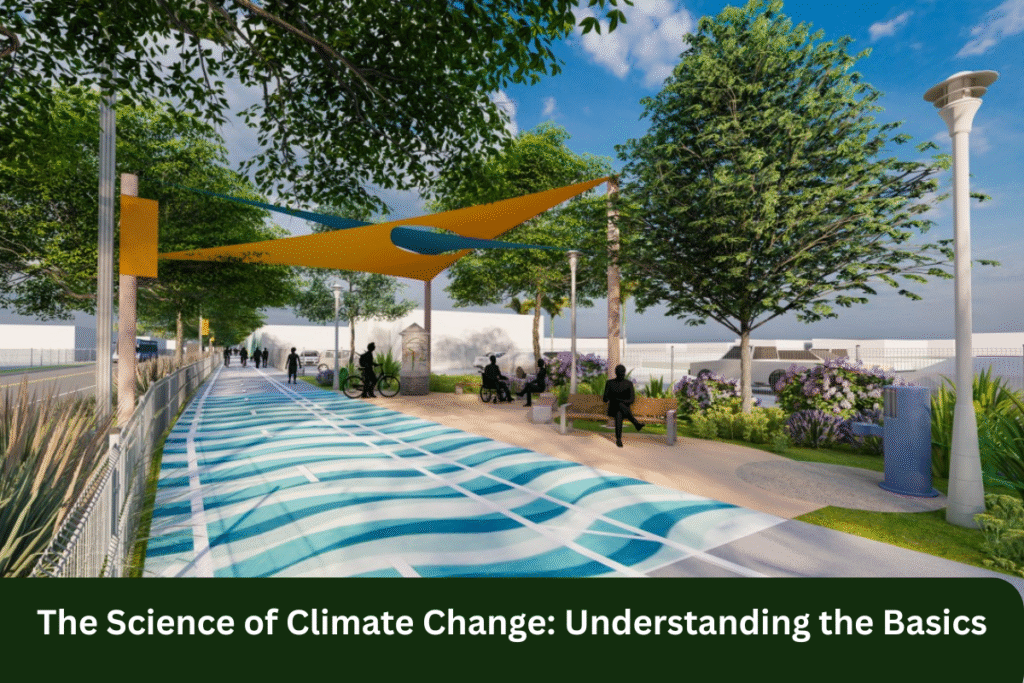
Climate change has become one of the most critical challenges of our time, affecting ecosystems, economies, and communities worldwide. But what exactly is climate change, and how do we understand the science behind it? In this article, we will break down the basic science of climate change, exploring its causes, impacts, and the evidence that drives global action to address this pressing issue.
1. What is Climate Change?
Climate change refers to long-term shifts and changes in temperature and weather patterns on Earth. While the Earth’s climate naturally varies over time, the term “climate change” today is most commonly used to describe significant changes in global or regional climates over an extended period, largely due to human activities.
The primary cause of modern climate change is the greenhouse effect, which occurs when certain gases in the Earth’s atmosphere trap heat, preventing it from escaping into space. This natural process is essential for life on Earth, but human activities, particularly the burning of fossil fuels, have dramatically increased the concentration of greenhouse gases, intensifying the greenhouse effect and leading to global warming.
2. The Greenhouse Effect and Greenhouse Gases
The greenhouse effect is a natural phenomenon that keeps the Earth warm enough to support life. The sun’s energy reaches the Earth, and some of it is reflected back into space, while the rest is absorbed by the Earth’s surface and oceans. The Earth then emits this absorbed energy as heat, or infrared radiation. Greenhouse gases in the atmosphere—such as carbon dioxide (CO2), methane (CH4), nitrous oxide (N2O), and water vapor—trap this heat, preventing it from escaping into space.
The Role of Greenhouse Gases:
- Carbon Dioxide (CO2): The primary greenhouse gas emitted by human activities, mainly from burning fossil fuels like coal, oil, and natural gas.
- Methane (CH4): A potent greenhouse gas emitted during agricultural activities, livestock digestion, and the production of natural gas.
- Nitrous Oxide (N2O): Released from agricultural activities, particularly the use of fertilizers and the cultivation of certain crops.
- Water Vapor: While it is a significant greenhouse gas, water vapor’s concentration is influenced by temperature. As the Earth warms, more water vapor enters the atmosphere, amplifying the greenhouse effect.
Human activities, such as industrialization, deforestation, and agriculture, have drastically increased the concentrations of these greenhouse gases, leading to enhanced warming—this is known as anthropogenic (human-caused) climate change.
3. The Evidence of Climate Change
The science behind climate change is based on robust evidence from various fields, including meteorology, oceanography, and environmental science. Some key indicators of climate change include:
a. Rising Global Temperatures
Global temperatures have been rising at an accelerated rate over the past century, with the last few decades seeing record-breaking heat levels. According to NASA, the global average temperature has increased by about 1.2°C (2.2°F) since the late 19th century, and the rate of warming is increasing.
b. Melting Ice Caps and Glaciers
One of the most visible signs of climate change is the melting of ice in polar regions and glaciers. The Arctic is warming at more than twice the global average, leading to the shrinking of ice sheets and glaciers, contributing to rising sea levels. This also disrupts ecosystems and affects freshwater supplies.
c. Rising Sea Levels
As the ice caps and glaciers melt, the resulting water flows into the oceans, causing sea levels to rise. Higher sea levels increase the risk of coastal flooding and erosion, threatening coastal communities and ecosystems.
d. Extreme Weather Events
There is increasing evidence that climate change is making extreme weather events more frequent and severe. This includes:
- Heatwaves: More frequent and intense periods of extreme heat.
- Flooding: Due to heavier rainfall and storm surges, leading to increased river and coastal flooding.
- Droughts: Longer and more intense dry periods affecting agriculture, water supply, and ecosystems.
- Hurricanes and Cyclones: More intense storms, fueled by warmer ocean temperatures.
e. Ocean Acidification
The increasing concentration of CO2 in the atmosphere also leads to higher levels of CO2 being absorbed by the oceans. This causes ocean acidification, which disrupts marine life, particularly organisms that rely on calcium carbonate for their shells and skeletons, such as corals and shellfish.
4. The Impacts of Climate Change
The impacts of climate change are widespread and interconnected, affecting ecosystems, human societies, and economies across the globe:
a. Ecosystems and Biodiversity
Rising temperatures and changing weather patterns are disrupting ecosystems and threatening biodiversity. Species that cannot adapt quickly enough face the risk of extinction. Shifting migration patterns, altered breeding seasons, and changes in food availability are affecting animals and plants worldwide.
b. Agriculture and Food Security
Climate change is affecting agricultural productivity due to altered rainfall patterns, increased pests and diseases, and more frequent extreme weather events. In many regions, this threatens food security and raises concerns about the stability of global food systems.
c. Human Health
Climate change poses direct and indirect health risks, including:
- Heat-related illnesses: Heatwaves can cause heatstroke, dehydration, and even death, particularly among vulnerable populations.
- Spread of diseases: Warmer temperatures allow vector-borne diseases, such as malaria and dengue, to spread to new regions.
- Air quality: Increased temperatures and air pollution contribute to respiratory problems, including asthma and bronchitis.
d. Economic Impact
The economic costs of climate change are significant. Damage to infrastructure, agricultural losses, and the costs of responding to extreme weather events strain economies. Additionally, climate change-induced displacement and migration can exacerbate social and economic instability in some regions.
5. Addressing Climate Change: Mitigation and Adaptation
Mitigating climate change involves reducing greenhouse gas emissions and transitioning to a low-carbon economy. Key strategies include:
- Transitioning to renewable energy: Solar, wind, and hydropower energy sources reduce reliance on fossil fuels.
- Energy efficiency: Improving energy use in buildings, transportation, and industries helps reduce emissions.
- Carbon capture: Technologies that capture and store CO2 emissions from industrial sources.
Adaptation involves making adjustments to social, economic, and environmental practices to reduce the negative impacts of climate change. This can include:
- Building resilient infrastructure: Preparing communities for extreme weather events and rising sea levels.
- Sustainable agriculture: Using climate-resilient crops and farming practices to ensure food security.
- Protecting ecosystems: Restoring mangroves, wetlands, and forests that provide natural climate protection.
6. FAQs
1. What is the main cause of climate change?
2. What are the effects of climate change?
3. How can we reduce the impact of climate change?
4. What is the greenhouse effect?
5. How is climate change impacting biodiversity?
7. Conclusion
Understanding the science of climate change is crucial for addressing its impacts and taking action to mitigate its effects. By recognizing the causes, evidence, and consequences of climate change, we can work towards sustainable solutions that reduce emissions, protect ecosystems, and build resilient communities. The urgency to act has never been greater, and through global cooperation and policy changes, we can work towards a more sustainable, climate-resilient future for all.
ChatGPT can make mistakes. Check important info. See Cookie Prefere
